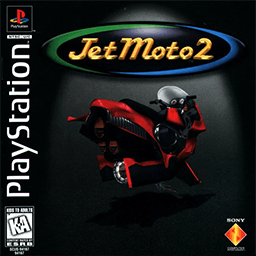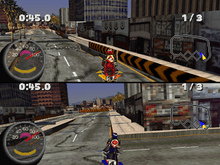Jet Moto 2
| Jet Moto 2 | |
|---|---|
 | |
| Developer(s) | SingleTrac |
| Publisher(s) | Sony Computer Entertainment |
| Composer(s) | Pinnacle Music Group[1] |
| Series | Jet Moto |
| Platform(s) | PlayStation, PlayStation Network |
| Release date(s) |
PlayStation PlayStation Network |
| Genre(s) | Racing |
| Mode(s) | Single player, multiplayer |
Jet Moto 2 (known as Jet Rider 2 in Europe and Jet Moto '98 in Japan) is a 1997 racing video game developed by SingleTrac and published by Sony Computer Entertainment for the PlayStation video game console. It is the sequel to the 1996 game Jet Moto. It was released in North America on October 31, 1997, in Europe in April 1998, and in Japan on August 6, 1998. In January 2008 Jet Moto 2 was made available for the PlayStation Portable and PlayStation 3 via the PlayStation Network. The PlayStation Greatest Hits version, branded within the game as Jet Moto 2: Championship Edition, is slightly different from the original in that the framerate is increased, the number of competitors is limited to four, and all the original Jet Moto tracks were unlocked from the start.
As with Jet Moto, gameplay in Jet Moto 2 revolves around the use of hoverbikes to traverse a race course, similar to modern day motorcross, but with the added ability to traverse water. Reviews for Jet Moto 2 were mixed. It currently holds a 70.08% at GameRankings, a video game aggregator. Reviewers felt the game was an improvement over the original, but again criticized its high difficulty. Jet Moto 2's popularity would spawn one additional sequel, Jet Moto 3.
Gameplay

Jet Moto 2 retains all of the basic gameplay from its predecessor. Players control hoverbikes which sit close to the ground and can be ridden over land and water. The courses in the game are designed to take advantage of this ability. Characters are split into teams, and bikes are adorned with logos of products such as Mountain Dew and JetSki, similar to real-life sponsored racing.[5] The riders received an overhaul, with only a total of ten selectable characters being available, and subsequently only ten racers on the track at any given time.[5]
The number of tracks available greatly increased, with ten new tracks added plus the ability to unlock all of the tracks from the original game. Track designs are more varied in Jet Moto 2, with each level containing a unique theme rather than the shared themes of the original. The courses range from earthquake-damaged cities, to desert canyons, ice-covered mountains, a roller coaster, and several other themes.
The difficulty was also increased in Jet Moto 2. In order to conserve CPU cycles for other things the developers used gameplay recordings in place of fully developed racer AI. As a result most AI racers have a perfect run and any mistakes made by the player result in a quick loss of top racing positions.[6] The PlayStation Greatest Hits version of the game, dubbed Jet Moto 2: Championship Edition further changed the gameplay mechanics. All Jet Moto tracks were immediately unlocked for the player. Additionally, the number of in-game racers would be reduced from ten to only four to allow the game to run at 30 frames per second.[7]
Development

Jet Moto 2's original cut from 20 competitors to 10 was "to open the game up to a broader market, one that wasn’t driven by hardcore."[7] Chef Boyardee was one of the new sponsors in the game, however the game's producer, Brian Wiklem fought to ensure the sponsor would not be a rider's sponsor. As a result, Chef Boyardee's logo was added to track advertisements throughout the tracks.[7] Of the ten new tracks created for the Jet Moto 2, five concepts were designed by SingleTrac, and five by Wiklem and his assistant.[7] Dual Analog Controllers and the accompanying vibration functions were supported for the first time, but DualShock Controllers were not. As with the first Jet Moto, Axiom Design created the user interface shell for the game.[1] Pinnacle Music Group composed the music for the game.[1] Jet Moto 2 would receive localized renames in Europe and Japan. Its European title is Jet Rider 2,[2] and its Japanese title is Jet Moto '98.[2]
The Greatest Hits version of the game was never meant to be released in its current form. As the game's production cycle was ending, Wiklem asked SingleTrac to modify the game for him a modified version of Jet Moto 2. This version increased the framerate to 30 frames per second by removing six competitors from races, thus putting less strain on the PlayStation hardware.[7] Additionally, Wiklem requested that all of the original Jet Moto tracks be unlocked at the start of the game.[7] It was branded in-game as Jet Moto 2: Championship Edition.
Due to their master disc being destroyed, Sony contacted Wiklem for a copy to use as a master disc for burning. Wiklem sent the altered disc SingleTrac had made for him, notifying Sony of the change and petitioning it be used as the Greatest Hits version.[7] Sony replied that Greatest Hits titles must be the same as the original release version. Dismayed, Wiklem burned a copy of the original version and sent it to Sony for duplication. Due to a mixup in the duplication process, the modified version of the game was duplicated and not the original version.[7] Sony Digital Audio Disc Corporation contacted Sony Computer Entertainment about the mix up, and eventually the discussions trickled down to Wiklem himself. He told vice president of marketing Jeff Fox that he "did send the right disc, it was properly labeled, and it’s not my fault that DADC couldn’t read."[7] The situation was put to rest shortly thereafter, with the decision being made not to make any further changes to the Greatest Hits disc.[7]
Reception
| Jet Moto 2 | ||||||||||||||||||||||
|---|---|---|---|---|---|---|---|---|---|---|---|---|---|---|---|---|---|---|---|---|---|---|
| ||||||||||||||||||||||
Jet Moto 2 received mixed reviews from critics. It currently holds a 70.08% at GameRankings, a video game aggregator.[8] Like Jet Moto, the game's popularity would earn it a spot in the PlayStation Greatest Hits. Between the original version and the Greatest Hits Championship Edition, Jet Moto 2 would go on to sell over 800,000 copies.[7]
Reviewers generally praised the new variety of tracks offered, and the fact that the original Jet Moto tracks could be unlocked.[5][11] GameSpot stated that the variety of courses "take the Jet Moto series yet another step away from the traditional racer."[5] Reviewers also noted improved graphics over the original, citing that the game seems to have a less polygonal look.[5] The improvements to the physics system were especially praised by IGN, calling them "even more over-the-top" and that the game was "simply more playable". GameSpot felt oppositely, stating that the physics seemed to have degenerated from the original game.[11] They noted that often a rider will fly off in an odd direction when thrown from the bike.[5]
As with the original reviewers felt that, though the gameplay had improved, it was still too difficult.[5][10] IGN noted that the product placement seemed excessive, and felt the game was not unique enough from the original in the end, calling it "Jet Moto 1.5".[11]
Legacy
Jet Moto 2 would be the last game developed by SingleTrac and published by Sony Computer Entertainment. Pacific Coast Power & Light would develop Jet Moto 3, with 989 Sports publishing the third title.[14] Jet Moto 3 would be released August 31, 1999 exclusively in North America. To date it is the last title in the series to be released. Two other titles were cancelled during their development. Pacific Coast Power & Light was also developing Jet Moto 2124 for the PlayStation, set over a century after the first three games, however the game was cancelled when Jet Moto 3 showed poor sales.[15] Jet Moto: SOLAR, developed by RedZone Interactive, was also cancelled. SOLAR would have been the first title in the series to appear on the PlayStation 2.[16]
References
- 1 2 3 "Jet Moto 2 – Credits – allgame". Allgame. Retrieved 2010-08-25.
- 1 2 3 4 "Jet Moto 2 Release Information for PlayStation – GameFAQs". GameFAQs. Retrieved 2008-03-27.
- ↑ McWhertor, Michael (2008-01-24). "PlayStation Store Update: Bandwidth May Cry". Kotaku. Retrieved 2010-08-27.
- ↑ Plunkett, Luke (2008-12-12). "PAL PlayStation Store Update". Kotaku. Retrieved 2010-08-27.
- 1 2 3 4 5 6 7 8 Deemer, Andy (1997-12-11). "Jet Moto 2 Review". GameSpot. Retrieved 2010-08-16.
- ↑ "Tales of the Rampant Coyote: Jet Moto Memories". Personal blog of Jay Barnson, former SingleTrac developer. 2007-01-16. Archived from the original on 2011-07-15. Retrieved 2010-08-06.
- 1 2 3 4 5 6 7 8 9 10 11 "Jet Moto 2". jet-x.com, personal site of Brian Wiklem, Jet Moto 2 producer. Retrieved 2010-08-13.
- 1 2 "Jet Moto 2 for PlayStation – GameRankings". GameRankings. Retrieved 2010-08-16.
- ↑ "Electronic Gaming Monthly" (July 2003).
- 1 2 Zimring, Jason (November 1997). "JetMoto Review". Game Revolution. Archived from the original on 1998-06-13. Retrieved 2010-08-06.
- 1 2 3 4 IGN Staff (1997-11-12). "Jet Moto 2". IGN. Retrieved 2010-08-16.
- ↑ "Official Playstation Magazine" (January 2003).
- ↑ Lucas, Victor (1999-01-25). "Electric Playground GAME REVIEWS: SONY – Jet Moto 2". Electric Playground. Retrieved 2010-08-09.
- ↑ "Jet Moto 3 Release Information for PlayStation – GameFAQs". GameFAQs. Retrieved 2008-08-13.
- ↑ Caoili, Eric (2010-02-26). "Jet Moto 2124 Retrospective, Syd Mead Designs". Game, Set, Watch. Retrieved 2010-08-13.
- ↑ "Jet Moto:SOLAR Game Design Document 2.4" (pdf). RedZone Interactive. Retrieved 2010-08-13.